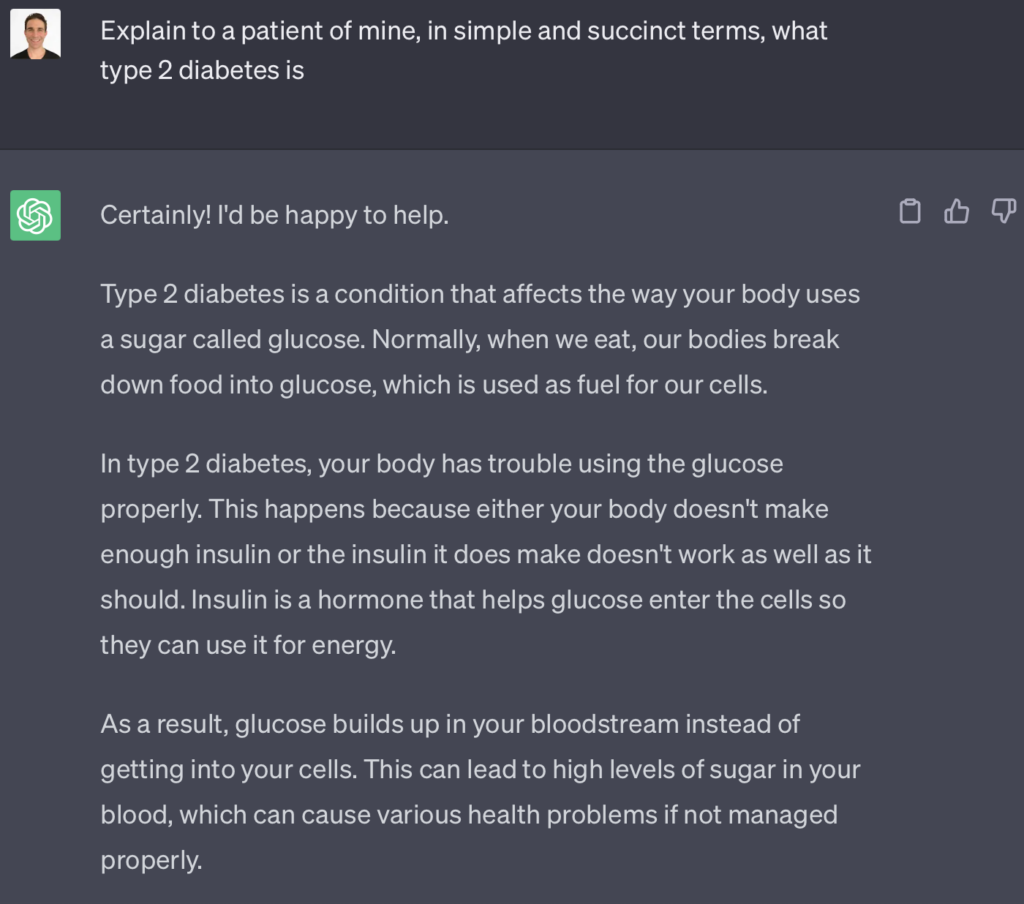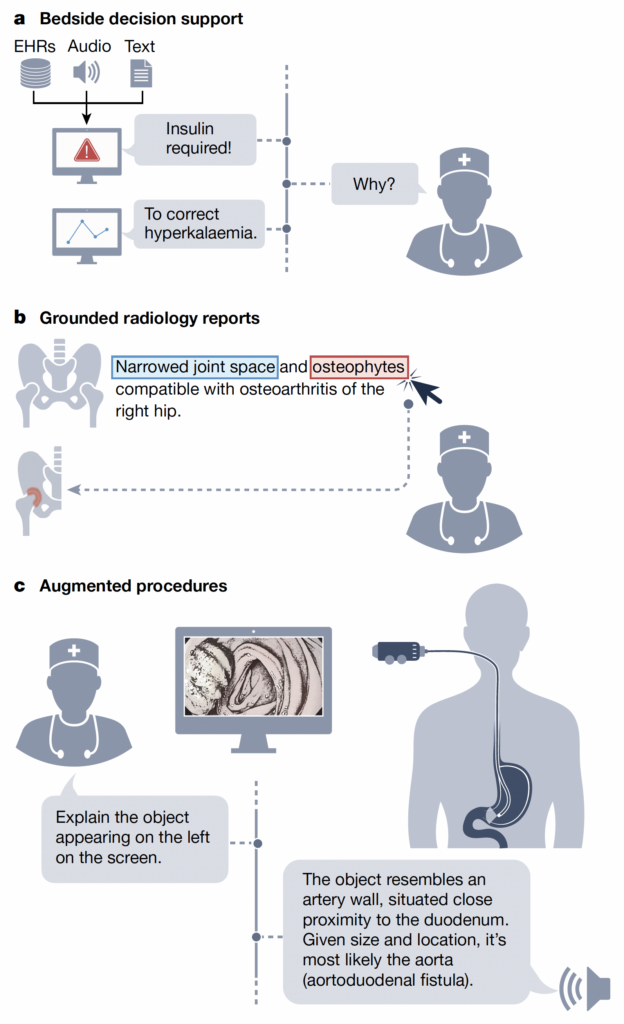27 May 2023 | Healthcare
Streamlining Healthcare Workflows with AI
By workweek
Generative artificial intelligence platforms like ChatGPT have fully infiltrated healthcare markets since OpenAI’s launch of ChatGPT back in November. One of the greatest use cases of generative AI is optimizing clinical and non-clinical workflows, saving physicians and providers hours of routine, mundane tasks each day.
Generative AI in healthcare is just heating up and is predicted to grow at a compound annual growth rate of 85% through 2027, reaching a total market size of $22 billion—the fastest growth compared to all other industries using generative AI.
In this article, I’ll provide background on generative AI (e.g., ChatGPT), recap what we’ve seen in the generative AI healthcare space since ChatGPT’s launch, and dive into my views and predictions.
The Deets
Generative AI is subset of artificial intelligence that generates texts, images, music, and even voice based on provided input. This input can take various forms, ranging from unstructured data to texts, numbers, or speech. Generative AI is built on large language models, which are machine learning models trained on massive datasets. These models acquire a deep understanding of human-like text, enabling them to generate and complete text with remarkable accuracy and fluency.
OpenAI’s ChatGPT is a generative AI model that can analyze whatever you write to it and respond back to you like it’s your buddy. ChatGPT can process input efficiently and produce a sensible output (in most cases). The ability of ChatGPT to quickly analyze unstructured data, make sense of it, and produce an output is exciting, especially when you think about its potential implications in healthcare.

Once OpenAI released ChatGPT, I wrote about it, emphasizing three core areas in healthcare that would greatly benefit from generative AI technology like ChatGPT:
- Patient care and delivery
- Research, diagnostics, and treatment
- Clinical and non-clinical workflow
Since ChatGPT launched in November, hundreds, if not thousands of services have launched utilizing generative AI to tackle the three core areas I mentioned above.
6 Months Post ChatGPT Launch: What’s Going On?
Six months after ChatGPT’s launch, the healthcare industry is rapidly embracing generative AI, showing no signs of slowing down. This transformative technology has not only spurred the launch of new AI-backed workflow services but has also fostered strategic partnerships between tech companies and health systems. Below I explore the most compelling AI-backed clinical and non-clinical workflow services as well as noteworthy partnerships.

New Startups
Two promising startups, Denyify and dotphrase.ai, are leveraging generative AI to enhance clinical and non-clinical workflows. Denyify simplifies claims and appeals processes, alleviating the frustrations physicians face when dealing with insurers. On the other hand, dotphrase.ai offers a real-time physician-built dictation platform that instantly converts dictations into progress notes or customized templates. While these startups are currently in the testing phase, their solutions address critical needs, and I’ll be closely following their progress.
Existing Startups
I split existing startups in the clinical and non-clinical workflow domain into three subgroups: clinical decision making, copilots, and note generation.
Clinical Decision Making
Dr. Dereck Paul and Graham Ramsey introduced Glass Health in 2021 to facilitate knowledge sharing among doctors for clinical decision making. Their latest innovation, Glass AI, combines a large language model with a curated clinical knowledge database, overcoming limitations typically associated with base large language models like ChatGPT. Glass AI provides reliable, up-to-date treatment plans within seconds, which can significantly improve patient care.
“Copilots”
Digital health company Nabla launched Nabla Copilot, which uses GPT-3 (the large language model for ChatGPT) to transform patient conversations into notes or other outputs. By listening to clinician-patient conversations, Nabla Copilot generates prescriptions, follow-up appointment letters, and consultation summaries, relieving clinicians of these tasks.
Suki, another company, integrated its AI voice assistant, Suki Assistant, into Epic, providing dictation features along with command-following capabilities.
Additionally, Doximity introduced DocsGPT, a ChatGPT tool, to assist physicians in drafting preauthorization and appeal letters to insurers, easing the burdensome preauthorization process.
Note Generation
Microsoft’s Nuance launched their Nuance Dragon Ambient eXperience (DAX) product, which is a fully automated clinical documentation app, capturing clinician-patient conversations and translating it automatically into notes using ChatGPT-4. DAX is integrated into EHRs, streamlining workflows. Note, this is different than dictation: Nuance is capturing natural (ambient) conversation and transforming it into a clinical note so the clinician doesn’t have to write one.
Similarly, Ambience released Ambience AutoScribe, a fully automated AI medical scribe integrated into EHRs, streamlining workflows by providing real-time notes immediately after patient encounters.
Partnerships
Several strategic partnerships have formed since November between health tech companies and health systems/EHRs.
- Microsoft and Epic are collaborating to develop and integrate generative AI into Epic’s EHRs.
- HCA Healthcare and Augmedix announced a partnership, with HCA investing $12 million in the digital clinical documentation company. Blake covered the details here.
- The University of Kansas Health System and Abridge are partnering to bring generative AI-powered medical documentation to over 1,500 practicing physicians.
- 3M Health Information Systems and Amazon Web Services (AWS) are working together to develop ambient clinical documentation and virtual assistant solutions using AWS’s generative AI.
These company launches, services, and partnerships have all occurred since the ChatGPT launch in November, demonstrating the remarkable momentum within the generative AI space.
Dash’s Dissection
Generative AI’s momentum will give companies in the space attractive funding opportunities. According to CB Insights, generative AI copilots for doctors (e.g., Nabla Copilot) have raised more than $240 million since 2018, with the number of deals trending upwards. I’m sure this area will start receiving substantial funding once the volatility of the economy cools. Rock Health also found $1.2. billion was raised in 2022 for digital health startups using AI for clinical decision support and precision medicine (unsure if this includes generative AI companies, though).
Given the momentum of the AI space, a common question that follows any mentioning of AI in healthcare is, “will AI replace clinicians?” Here’s my answer:
No.
AI—especially generative AI—will augment clinicians’ performance by relieving them of burdensome bureaucratic work, allowing them to leverage their creative thinking and expertise to solve patient problems. In fact, I prefer the term Augmented Intelligence as opposed to Artificial Intelligence to describe these companies using this technology to streamline workflows. Physicians will soon have a virtual assistant that doesn’t fatigue and can reliably perform when it comes to writing prior authorization appeals, clinical notes, or responding to patient questions.
Furthermore, I agree with Thomas Fuchs, Chair of the Department of Artificial Intelligence and Human Health at Mount Sinai, who said, “In healthcare, patients are currently losing their lives not due to AI, but due to the absence of AI.” Just envision the possibilities of having a virtual assistant that tirelessly monitors patients’ labs, imaging reports, and medications 24/7, preemptively alerting clinicians before any potential complications arise. Dr. Eric Topol, in his insightful newsletter, further emphasized this point, providing a compelling visualization (see to the graphic below).

Despite the excitement and infinite benefits of integrating generative AI into healthcare, there must be guardrails. As of now, we must remain a bit skeptical of these generative AI models and approach them with a “trust but verify” mindset. There is bias inherent in the training of these large language models, which means the output generated by these models may also included biases. These concerns are shared among health organizations such as WHO and the FDA, which both call for rapid and agile regulation around these large language models, given the pace at which they’re advancing. This is precisely why the Biden administration released a blueprint for an AI Bill of Rights.
In summary, generative AI, exemplified by OpenAI’s ChatGPT, has infiltrated healthcare and has the potential to greatly improve clinical and non-clinical workflows. Emerging startups and established entities alike are harnessing this technology to enhance efficiency, while strategic partnerships are being formed to further its potential. However, as we must embrace this technology with slight skepticism, given the inherent biases in AI and the need for appropriate regulation. Generative AIs ultimate promise lies in augmenting clinicians’ abilities, reducing administrative burdens, and improving patient outcomes.
Stay ahead in healthcare with my weekly Healthcare Huddle newsletter, covering digital health, policy, and business trends for 30,000+ professionals. Share with colleagues and subscribe here.